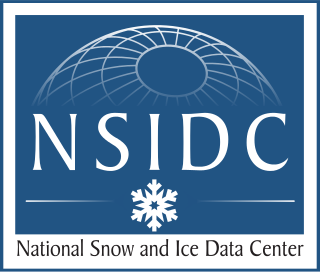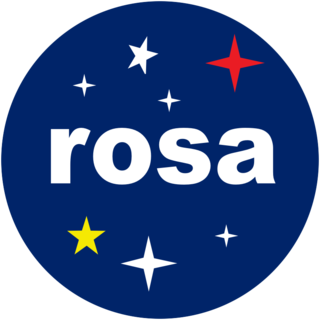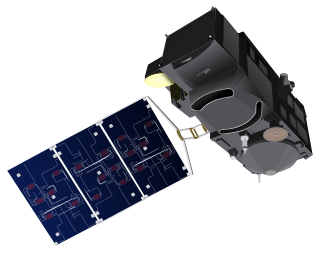Related Research Articles

An Earth observation satellite or Earth remote sensing satellite is a satellite used or designed for Earth observation (EO) from orbit, including spy satellites and similar ones intended for non-military uses such as environmental monitoring, meteorology, cartography and others. The most common type are Earth imaging satellites, that take satellite images, analogous to aerial photographs; some EO satellites may perform remote sensing without forming pictures, such as in GNSS radio occultation.
The Earth Observing System (EOS) is a program of NASA comprising a series of artificial satellite missions and scientific instruments in Earth orbit designed for long-term global observations of the land surface, biosphere, atmosphere, and oceans. Since the early 1970s, NASA has been developing its Earth Observing System, launching a series of Landsat satellites in the decade. Some of the first included passive microwave imaging in 1972 through the Nimbus 5 satellite. Following the launch of various satellite missions, the conception of the program began in the late 1980s and expanded rapidly through the 1990s. Since the inception of the program, it has continued to develop, including; land, sea, radiation and atmosphere. Collected in a system known as EOSDIS, NASA uses this data in order to study the progression and changes in the biosphere of Earth. The main focus of this data collection surrounds climatic science. The program is the centrepiece of NASA's Earth Science Enterprise.

The World Climate Research Programme (WCRP) is an international programme that helps to coordinate global climate research. The WCRP was established in 1980, under the joint sponsorship of the World Meteorological Organization (WMO) and the International Council for Science (ICSU), and has also been sponsored by the Intergovernmental Oceanographic Commission (IOC) of UNESCO since 1993.

The National Snow and Ice Data Center (NSIDC) is a United States information and referral center in support of polar and cryospheric research. NSIDC archives and distributes digital and analog snow and ice data and also maintains information about snow cover, avalanches, glaciers, ice sheets, freshwater ice, sea ice, ground ice, permafrost, atmospheric ice, paleoglaciology, and ice cores.
EUMETCast is a method of disseminating various meteorological data operated by the European Organisation for the Exploitation of Meteorological Satellites (EUMETSAT). The main purpose is the dissemination of EUMETSAT's own data, but various data from other providers are broadcast as well. EUMETCast is a contribution to GEONETCast and IGDDS and provides data for GEOSS and GMES.

The Cooperative Institute for Research in Environmental Sciences (CIRES) is a research institute that is sponsored jointly by the National Oceanic and Atmospheric Administration (NOAA) Office of Oceanic and Atmospheric Research (OAR) and the University of Colorado Boulder (CU). CIRES scientists study the Earth system, including the atmosphere, hydrosphere, cryosphere, biosphere, and geosphere, and communicate these findings to decision makers, the scientific community, and the public.

The Global Atmosphere Watch (GAW) is a worldwide system established by the World Meteorological Organization – a United Nations agency – to monitor trends in the Earth's atmosphere. It arose out of concerns for the state of the atmosphere in the 1960s.
Earth observation (EO) is the gathering of information about the physical, chemical, and biological systems of the planet Earth. It can be performed via remote-sensing technologies or through direct-contact sensors in ground-based or airborne platforms.
The Global Climate Observing System (GCOS) was established in 1992 as an outcome of the Second World Climate Conference, to ensure that the observations and information needed to address climate-related issues are obtained and made available to all potential users. The GCOS is co-sponsored by the World Meteorological Organization (WMO), the Intergovernmental Oceanographic Commission (IOC) of UNESCO, the United Nations Environment Programme (UNEP), and the International Council for Science (ICSU). In order to assess and monitor the adequacy of in-situ observation networks as well as satellite-based observing systems, GCOS regularly reports on the adequacy of the current climate observing system to the United Nations Framework Convention on Climate Change (UNFCCC), and thereby identifies the needs of the current climate observing system.

Copernicus is the Earth observation component of the European Union Space Programme, managed by the European Commission and implemented in partnership with the EU Member States, the European Space Agency (ESA), the European Organisation for the Exploitation of Meteorological Satellites (EUMETSAT), the European Centre for Medium-Range Weather Forecasts (ECMWF), the Joint Research Centre (JRC), the European Environment Agency (EEA), the European Maritime Safety Agency (EMSA), Frontex, SatCen and Mercator Océan.

The Romanian Space Agency is a public institution that coordinates Romania's national space technology research programs and activities related to space research. ROSA, established in 1991, is subordinate to the Romanian Ministry of Education.

Over the last two centuries many environmental chemical observations have been made from a variety of ground-based, airborne, and orbital platforms and deposited in databases. Many of these databases are publicly available. All of the instruments mentioned in this article give online public access to their data. These observations are critical in developing our understanding of the Earth's atmosphere and issues such as climate change, ozone depletion and air quality. Some of the external links provide repositories of many of these datasets in one place. For example, the Cambridge Atmospheric Chemical Database, is a large database in a uniform ASCII format. Each observation is augmented with the meteorological conditions such as the temperature, potential temperature, geopotential height, and equivalent PV latitude.
The Group on Earth Observations (GEO) coordinates international efforts to build a Global Earth Observation System of Systems (GEOSS). It links existing and planned Earth observation systems and supports the development of new ones in cases of perceived gaps in the supply of environment-related information. It aims to construct a global public infrastructure for Earth observations consisting of a flexible and distributed network of systems and content providers.
The Royal Belgian Institute for Space Aeronomy (BIRA-IASB) is a Belgian federal scientific research institute. Created in 1964, its main tasks are research and public service in space aeronomy, which is the physics and chemistry of the atmosphere of the Earth and other planets, and of outer space. The scientists rely on ground-based, balloon-, air- or space-borne instruments and computer models.

Sentinel-3 is an Earth observation heavy satellite series developed by the European Space Agency as part of the Copernicus Programme. It currently consists of 2 satellites: Sentinel-3A and Sentinel-3B. After initial commissioning, each satellite was handed over to EUMETSAT for the routine operations phase of the mission. Two recurrent satellites— Sentinel-3C and Sentinel-3D— will follow in approximately 2025 and 2028 respectively to ensure continuity of the Sentinel-3 mission.
Circumarctic Environmental Observatories Network (CEON) is a network of terrestrial and freshwater observation platforms, science experts and network partners promoting the collection and dissemination of environmental data from the Arctic. CEON observation platforms include land and freshwater observatories, research infrastructures, former research sites where retrospective analyses are being or can be undertaken, data and image archive centers and community monitoring programs.

The Croatian Meteorological and Hydrological Service is a public entity for meteorology, hydrology and air quality in Croatia.

The Joint Polar Satellite System (JPSS) is the latest generation of U.S. polar-orbiting, non-geosynchronous, environmental satellites. JPSS will provide the global environmental data used in numerical weather prediction models for forecasts, and scientific data used for climate monitoring. JPSS will aid in fulfilling the mission of the U.S. National Oceanic and Atmospheric Administration (NOAA), an agency of the Department of Commerce. Data and imagery obtained from the JPSS will increase timeliness and accuracy of public warnings and forecasts of climate and weather events, thus reducing the potential loss of human life and property and advancing the national economy. The JPSS is developed by the National Aeronautics and Space Administration (NASA) for the National Oceanic and Atmospheric Administration (NOAA), who is responsible for operation of JPSS. Three to five satellites are planned for the JPSS constellation of satellites. JPSS satellites will be flown, and the scientific data from JPSS will be processed, by the JPSS – Common Ground System (JPSS-CGS).
The Committee on Earth Observation Satellites (CEOS) is an international organization created in 1984 around the topic of Earth observation satellites.
References
- ↑ US Environmental Protection Agency
- ↑ Group on Earth Observations — The GEO Secretariat Director Archived October 10, 2008, at the Wayback Machine
- ↑ European Commission
- ↑ "Directions Magazine". Archived from the original on 2007-08-04. Retrieved 2008-01-25.
- ↑ "Institute of Electrical and Electronics Engineers". Archived from the original on 2007-10-19. Retrieved 2008-01-25.
- ↑ GEOSS Registries
- ↑ Reuters
- ↑ Associated Press
- ↑ "Information available through GEONETCast" (PDF). Archived from the original (PDF) on 2016-03-05. Retrieved 2011-05-09.
- ↑ "Useful data from DevCoCast project". Archived from the original on 2012-01-28. Retrieved 2011-05-09.
- ↑ ENDELEO, a useful vegetation map allowing comparison of vegetation over time, part of "Kenyan Forests" DevCoCast project
- ↑ "Global Biodiversity Information Facility". Archived from the original on 2009-03-05. Retrieved 2018-03-21.
- ↑ GEO Energy Community of Practice
- ↑ Reuters
- ↑ The Christian Science Monitor
- ↑ "The GIGAS Forum". Archived from the original on 2009-08-14. Retrieved 2009-08-05.
- ↑ GEO's Societal Benefit Areas
- Chuvieco, Emilio (2008) Earth Observation of Global Change: The Role of Satellite Remote Sensing in Monitoring the Global Environment Springer ISBN 9781402063572 page 10
- Luzeaux, Dominique; Ruaul, Jean-René (eds) (2013) Systems of Systems John Wiley & Sons ISBN 9781118619803 pg 215-218